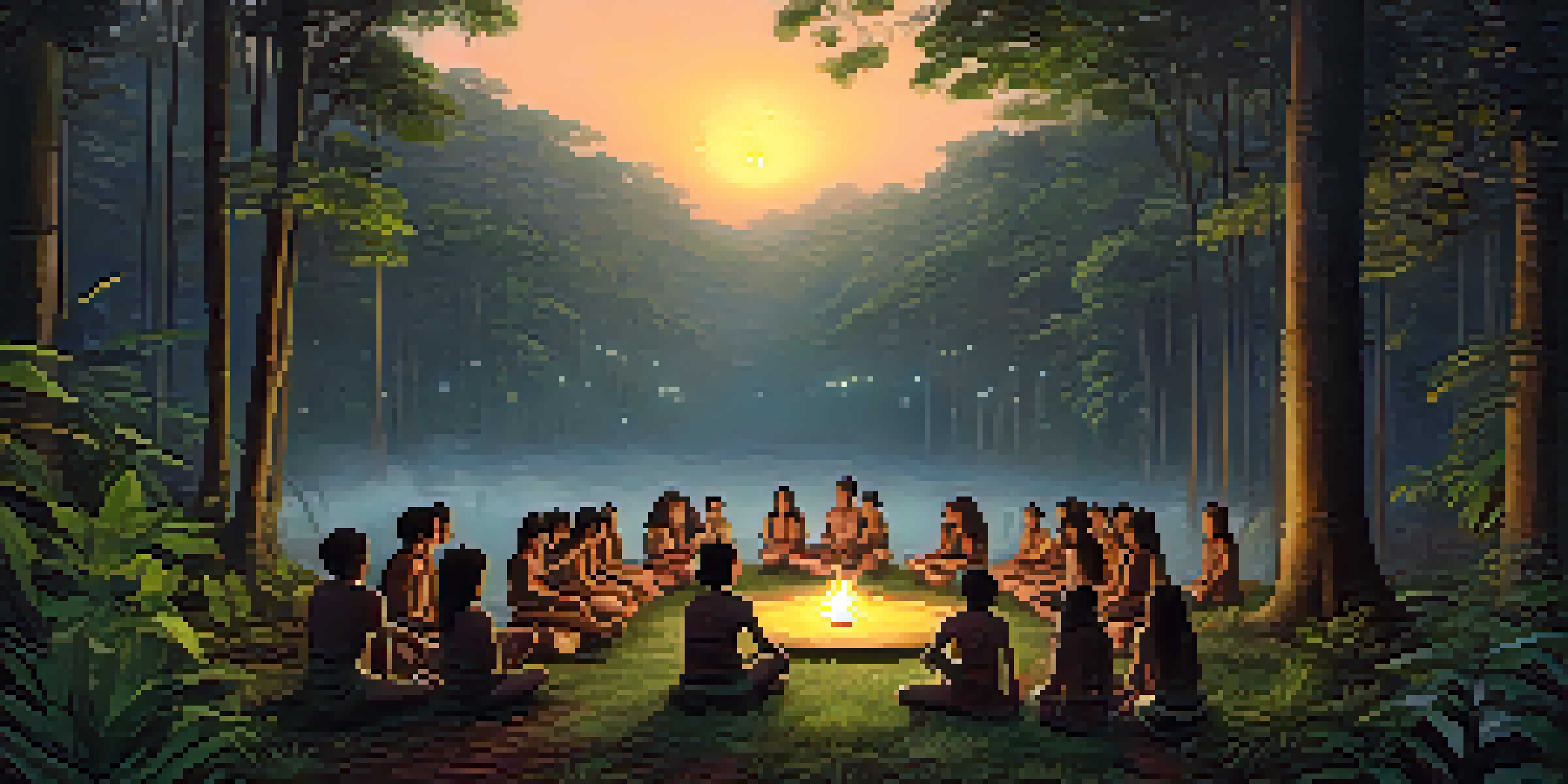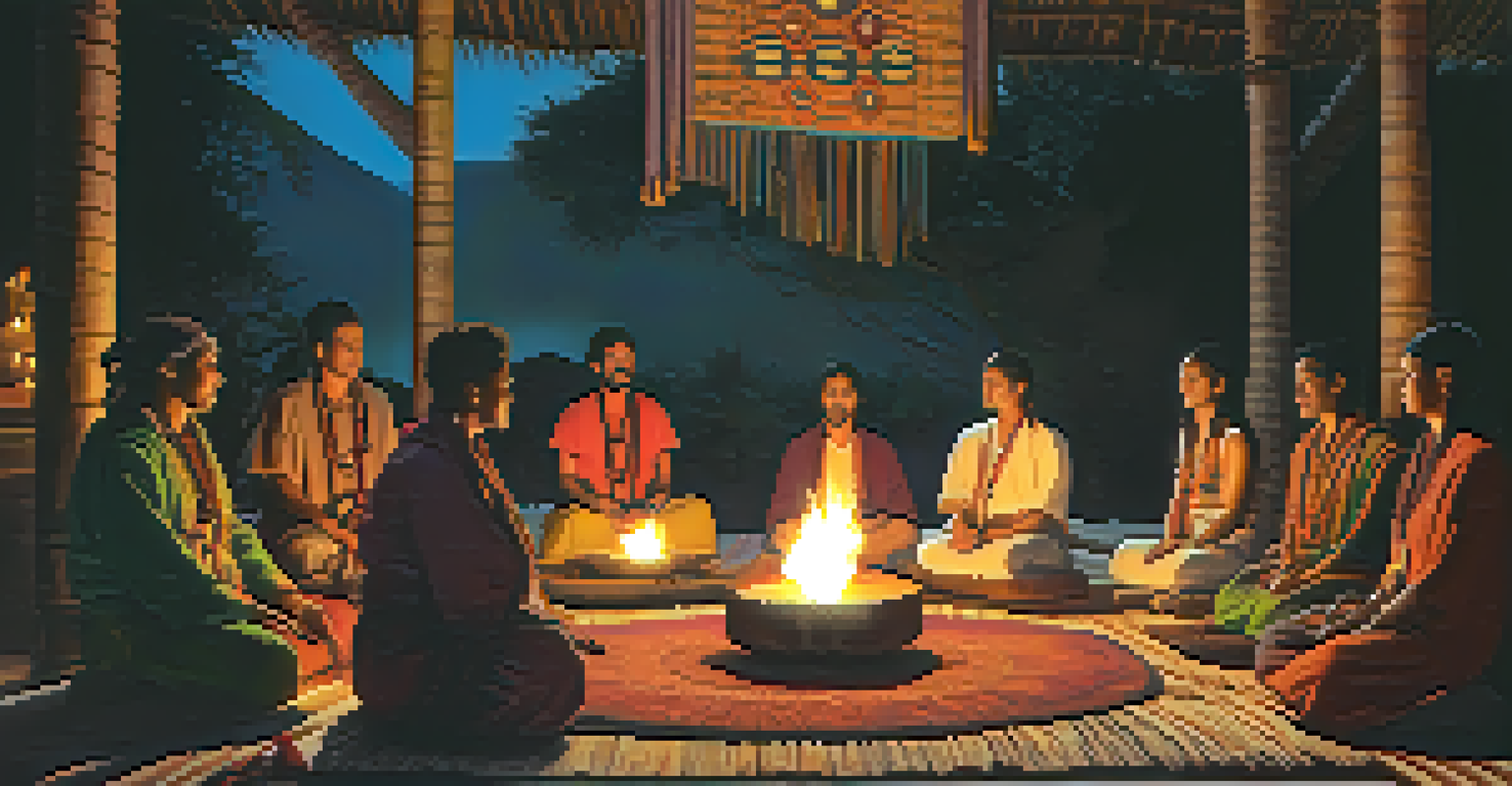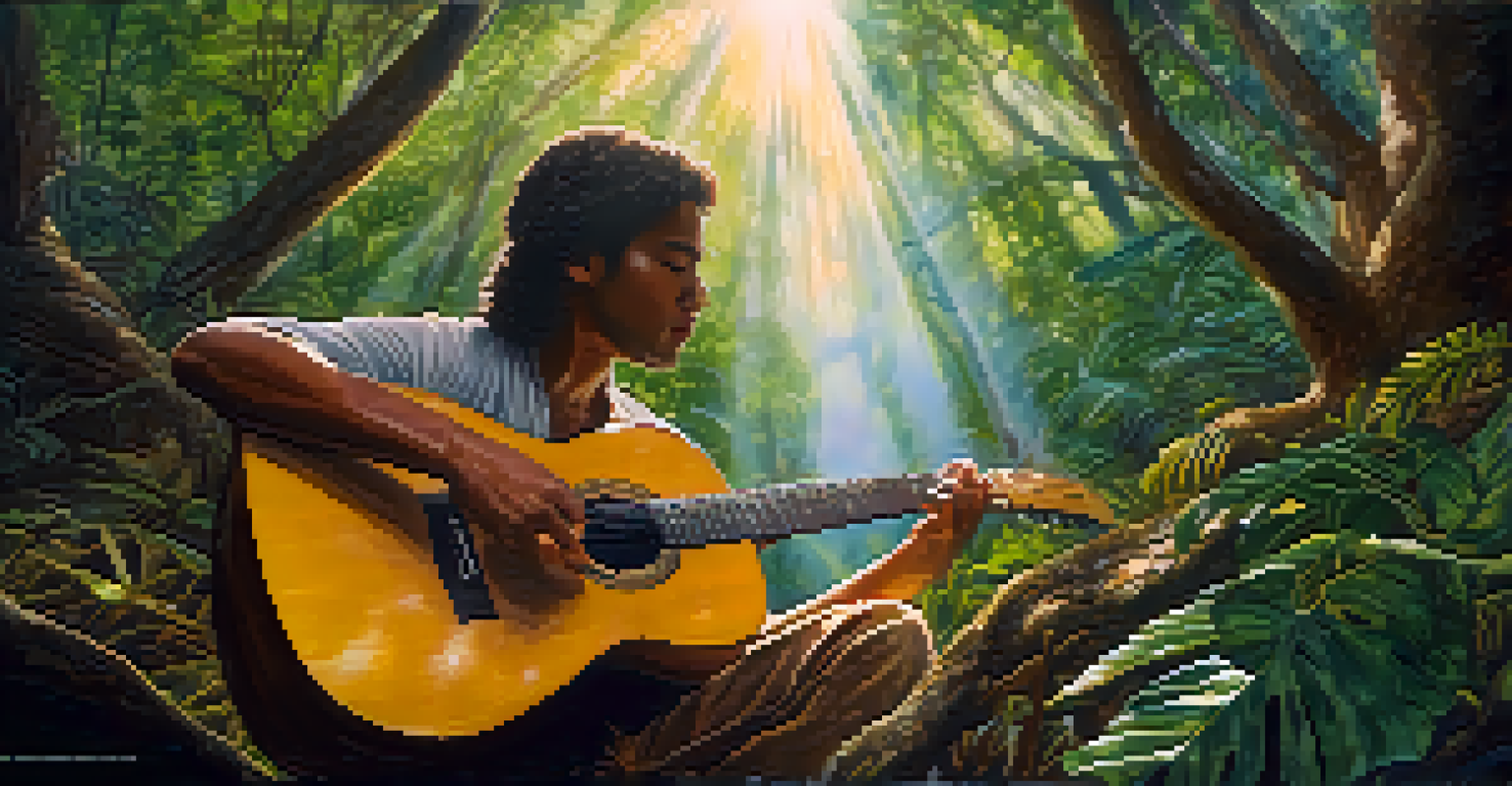The Role of Music and Songs in Ayahuasca Ceremonies

Understanding Ayahuasca and Its Ceremonial Context
Ayahuasca is a powerful brew made from the Banisteriopsis caapi vine and other plants, traditionally used in Amazonian shamanic rituals. These ceremonies are deeply spiritual experiences, allowing participants to explore their consciousness and connect with nature. The setting is often intimate, taking place in a darkened space where participants can feel safe and supported.
Music can change the world because it can change people.
In this context, music plays a pivotal role, serving as a guiding force throughout the ceremony. The soundscapes crafted by the shamans can evoke a range of emotions, helping participants navigate their journeys. Essentially, the music acts as a bridge between the physical and spiritual realms, enhancing the overall experience.
Without music, the atmosphere would be starkly different; silence can lead to unease or distraction. The rhythmic melodies and chants provide a sense of structure, allowing participants to surrender to the experience. This intertwining of music and ritual creates a unique environment for healing and self-discovery.
The Instrumentation Used in Ayahuasca Ceremonies
The instruments used in Ayahuasca ceremonies are often traditional and imbued with cultural significance. Common instruments include the guitar, flutes, and drums, each contributing unique sounds that resonate with the participants. These instruments not only add to the ambiance but also help in creating a communal atmosphere.

For instance, the gentle strumming of a guitar can evoke feelings of nostalgia or peace, while the deep beats of a drum can stir primal instincts and deep emotions. This combination of sounds can lead to a profound emotional release, allowing participants to confront hidden fears or unresolved issues. Additionally, the use of traditional instruments connects participants with the ancient practices of indigenous cultures.
Music Enhances Ayahuasca Journeys
The integration of music during Ayahuasca ceremonies serves as a vital tool for emotional exploration and healing.
Moreover, the live performance aspect of these ceremonies fosters a sense of intimacy and connection among participants. As the music flows, individuals often feel a shared experience, reinforcing community bonds. This communal aspect is crucial in creating a safe space for vulnerability during the often intense journey of self-exploration.
The Power of Icaros in Ayahuasca Ceremonies
Icaros are traditional songs sung by shamans during Ayahuasca ceremonies, playing a central role in guiding participants through their experiences. These songs, often described as 'spiritual medicine,' are believed to carry healing vibrations and are passed down through generations. Each icaros is unique and tailored to the specific needs of the ceremony, creating a personalized experience for participants.
The journey of a thousand miles begins with one step.
The lyrics of icaros often draw upon themes of nature, spirituality, and healing, resonating deeply with those present. As participants listen, they may find themselves transported to different emotional or spiritual states, allowing for deeper introspection. The shamans' voices, combined with the melodies, create an atmosphere of safety and support, helping individuals confront their inner challenges.
Furthermore, the use of icaros can evoke memories and emotions that participants may need to process. They act as a catalyst for reflection, assisting individuals in their healing journeys. This connection to the music often transcends the words, tapping into a universal understanding of human experience.
Music as a Tool for Emotional Release
During Ayahuasca ceremonies, music serves as a powerful tool for emotional release. Participants often experience a range of emotions, from joy to sadness, and the right music can help facilitate this process. By resonating with participants' feelings, music helps them navigate their journeys and encourages catharsis.
For example, a heart-wrenching melody can evoke tears, allowing participants to release pent-up emotions that may have been buried for years. This emotional release is an essential aspect of the healing process, enabling individuals to confront their pain and move forward. The therapeutic power of music taps into our innate human responses, making it a vital component of the experience.
Icaros Guide Healing Experiences
Icaros, traditional songs sung by shamans, play a central role in guiding participants through their spiritual journeys.
Moreover, the music can also uplift spirits, creating moments of joy and connection. In these moments, participants may feel a sense of unity with others and the universe, enhancing their overall experience. The ebb and flow of emotions, guided by music, provide a safe space for healing and transformation.
Creating a Safe and Supportive Environment
The role of music in Ayahuasca ceremonies extends beyond the individual experience; it also fosters a sense of safety and support among participants. A thoughtfully curated musical selection helps create an environment where individuals feel comfortable exploring their inner worlds. This supportive atmosphere is crucial, as vulnerability is often a key component of the healing journey.
As participants listen to calming melodies or engaging rhythms, they may find it easier to let go of their inhibitions and fears. Music can provide a comforting presence, reminding individuals that they are not alone in their experiences. This shared journey often leads to deeper connections among participants, encouraging mutual support and understanding.
Additionally, the music can act as a signal for different phases of the ceremony, helping participants understand the emotional landscape they are navigating. By signaling transitions through music, shamans can help participants prepare for what lies ahead. This intentional use of music reinforces the importance of a nurturing environment for healing.
The Influence of Cultural Heritage on Ceremony Music
The music played during Ayahuasca ceremonies is deeply rooted in the cultural heritage of the Amazonian tribes. Each community has its unique styles and traditions, which influence the melodies and rhythms used during ceremonies. This cultural richness adds layers of meaning to the music, enhancing the overall experience for participants.
For instance, different tribes may use specific instruments or singing styles that reflect their beliefs and practices. This diversity allows participants to connect with the ancestral wisdom embedded in the music, deepening their journey. The cultural context enriches the experience, providing participants with insights into the spiritual traditions of the Amazon.
Cultural Music Deepens Connections
The diverse musical traditions of Amazonian tribes enrich the Ayahuasca experience, fostering a sense of community and shared understanding.
Moreover, the incorporation of various cultural elements can lead to a more inclusive environment, allowing participants from different backgrounds to appreciate the shared human experience. This blending of traditions creates a mosaic of sounds and emotions, making each ceremony a unique journey. In this way, music becomes a bridge that connects participants to the rich tapestry of human culture.
Integrating Music into Personal Healing Practices
For many, the transformative power of music experienced during Ayahuasca ceremonies can be integrated into personal healing practices beyond the ritual. Participants often find that certain melodies or rhythms resonate with them long after the ceremony has ended. By incorporating music into their daily lives, individuals can continue their healing journeys.
Listening to specific songs or genres can evoke the same emotions experienced during the ceremony, providing a touchstone for introspection. Creating personal playlists or engaging in music therapy can help maintain the emotional connections formed during the ceremony. This practice allows individuals to explore their feelings and promote healing on their own terms.

Additionally, participants may find inspiration in the music of other cultures, drawing from a diverse range of sounds and traditions. This exploration can lead to a deeper understanding of one's emotional landscape, fostering growth and transformation. Ultimately, integrating music into personal healing practices can amplify the benefits of the Ayahuasca experience.